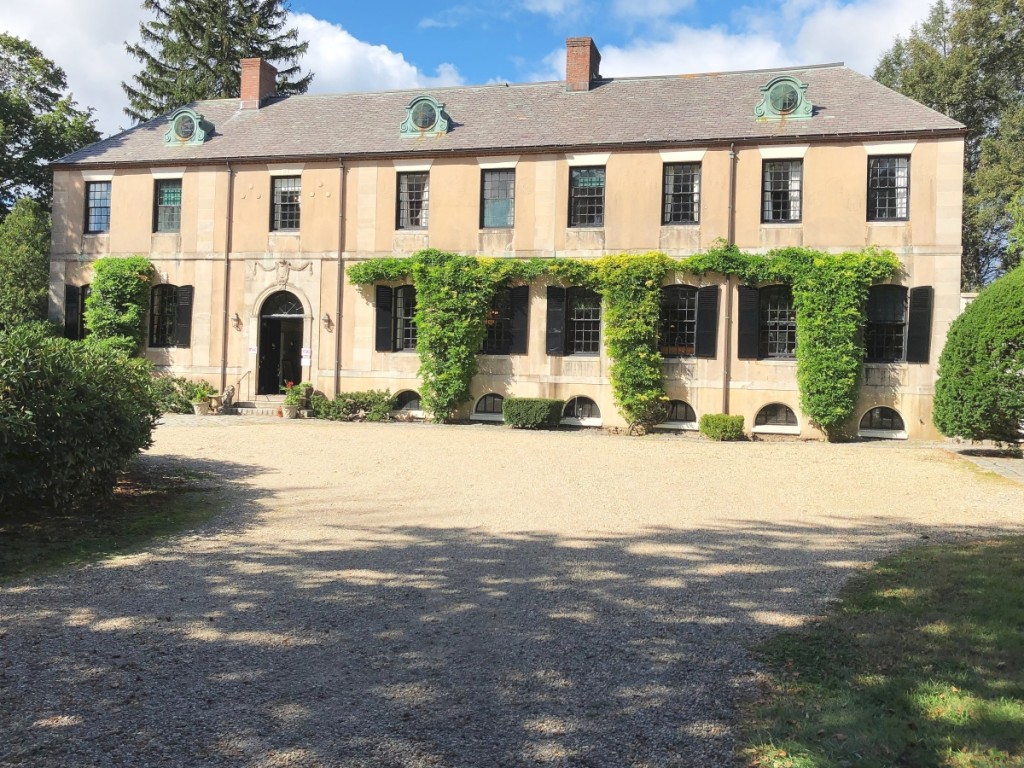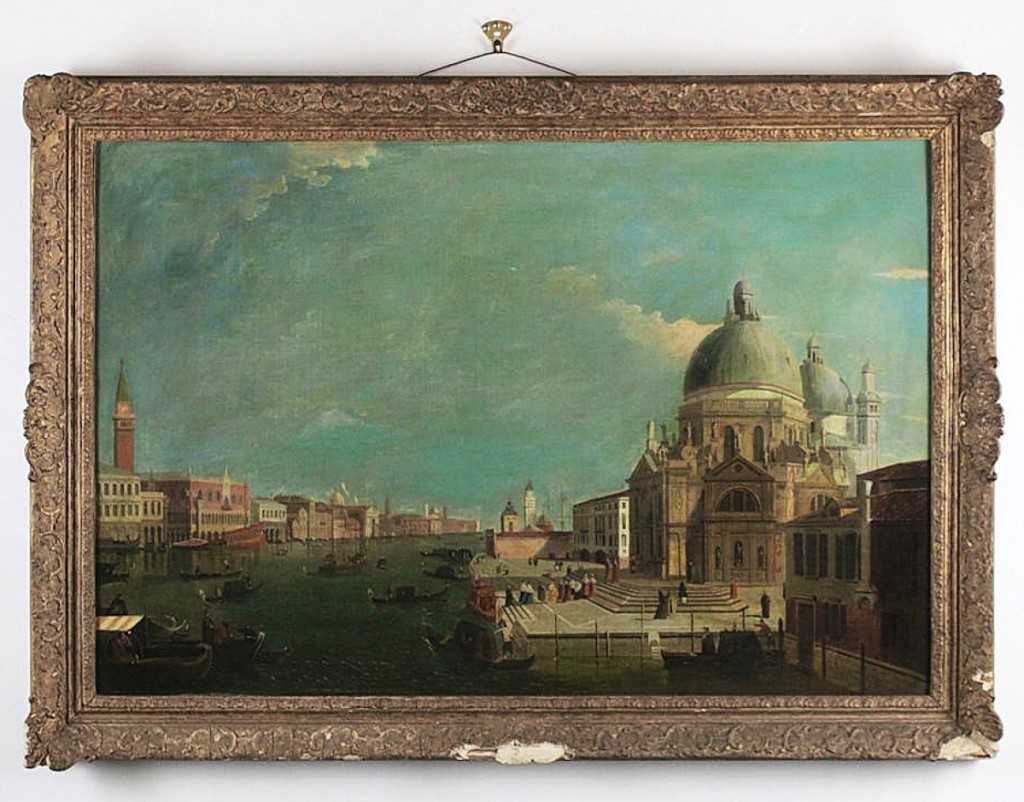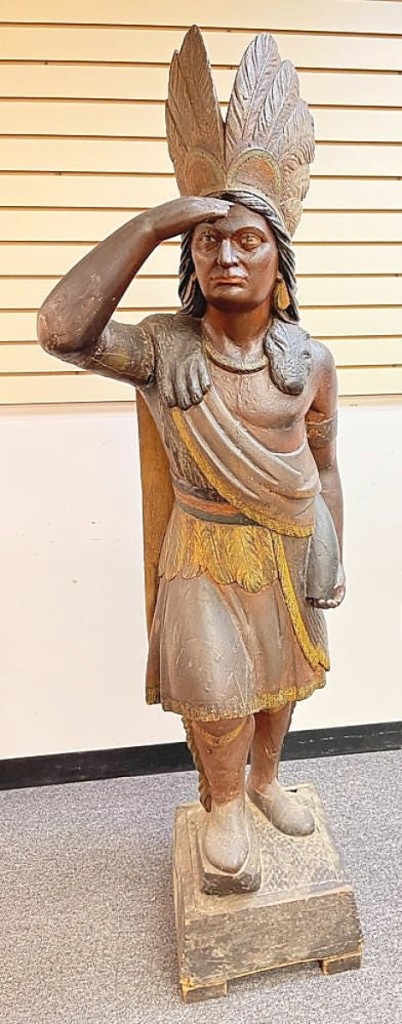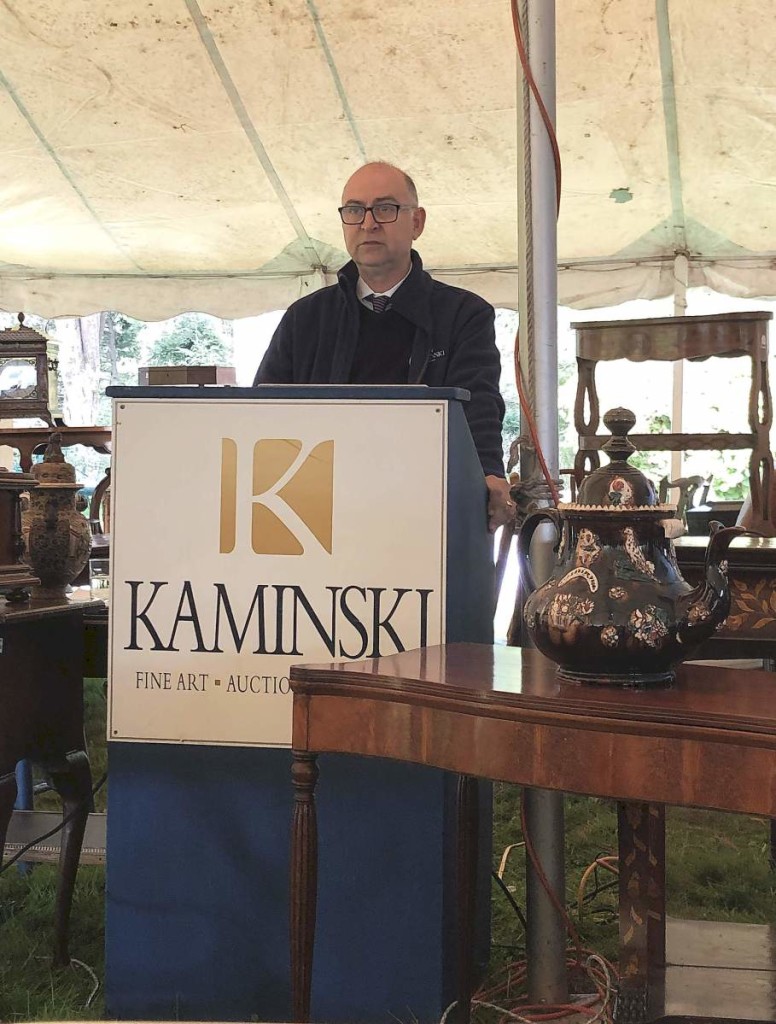
The entrance to the large, 11-bedroom home. The home and the 40-acre property are now under contract.
Review and Onsite Photos by Rick Russack, Catalog Photos Courtesy Kaminski Auctions
IPSWICH, MASS. – Waldingfield, the 11-bedroom home of Donald Curiale and his husband, the late Arthur J. Finkelstein, in Ipswich is a spectacular 40-acre estate, with a house built in 1929. In one of the wealthiest areas of the state, it overlooks the Ipswich River with formal gardens, some of which were designed by Frederick Law Olmstead, a French tree allée, old stone walls, horse trails, a barn, a caretaker’s lodge and, of course, horses. The couple, together for 51 years, purchased Waldingfield in 1984 and raised two daughters there.
The home is built on the footprint of an opulent home on the original Appleton farm, which burned earlier in the Twentieth Century. The farm, established in 1638, was until the 1984 sale, one of the oldest farms in the country remaining in original hands. The farm was part of a land-grant dating back to 1640 to Samuel Appleton. The Appleton family, one of the wealthiest in Massachusetts, at one time owned the company that became the Waltham Watch Co. Much of that original land-grant, about 1,000 acres, is currently owned by The Trustees of Reservations, a nonprofit land conservation and historic preservation organization dedicated to preserving natural and historical places in the Commonwealth of Massachusetts. The trustees maintain the property as a working farm, with dairy and beef herds, and produce a variety of agricultural products. The property, with its many trails, is open to the public. Parts of several surrounding properties are also in conservation trusts, collectively known as the Essex County Green Belt, and are also open to the public.
In case you didn’t know about the area, it was easy to tell you were in horse country. As you drove towards the auction site, you passed large, old homes with extensive green pastures, rustic fences and horses browsing. A minor detail clearly demonstrated that Waldingfield had always been owned by horse lovers. The rear facade of the stone house has a frieze running the entire length that is carved with equestrian figures and scenes.
Both owners of Waldingfield, Curiale and Finkelstein, were dedicated horsemen, members of the exclusive, nearby Myopia Hunt Club, and regularly participated in the club’s fox hunts. The unusual name of the club was selected because, as the story goes, two of the original founders had myopia. In addition to fox hunting, the club has a championship golf course that hosted four US Open tournaments. Its polo field was created in 1888, and regular polo matches are still played using the original field. Many are high-society events, and in the past, the club attracted players such as the former duke of Wales, later King Edward VIII, who abdicated in 1936. Princess Grace of Monaco and Princess Anne have attended. Fox hunting, which still continues, began in 1882. (Hunts are “drag hunting” – no live foxes are involved. Today, the scent of fox is laid down by the use of a spray, which the dogs, working as 12 “couples” have been trained to follow over several trails on adjoining properties.) Numerous equine events take place at the Hunt Club throughout the year.
Finklestein, who died in 2017, was a notable and successful New York-based conservative political consultant who advised the political campaigns of numerous presidents, such as Ronald Reagan and Richard Nixon; senators, including Jesse Helms, Alphonse D’Amato, and James Buckley; governors and heads of several European countries, including Israel’s Benjamin Netanyahu. His specialties included polling, strategy, messages, media, ad placement, etc. His library included numerous autographed books, given to him by world leaders. His entry on Wikipedia is one of the longest on the site and reads like a who’s who of conservative leaders. When asked how the couple selected Ipswich for a home in the 1980s, Don Curiale said, “Art traveled a lot and we needed a place near an airport. Here we have the airport in Beverly and, of course, Logan. We were considering this place, which we both loved the moment we pulled into the driveway, and a property in Palm Beach, Fla. We had decided to take whichever one came through first and here we are. We’ve been here since 1984 and we always considered Waldingfield to be our real home, although we had other properties.”
Kaminski supplemented the furnishings of Waldingfield with select additions from the estates of Anthony Athenas, whose property will be sold later this month, descendants of the August Busch family and a Palm Beach estate. There were dozens of paintings, including numerous marine paintings, elaborate silver sets, a Tiffany lamp, a cigar store Indian, European and American furniture, several large Oriental rugs, porcelain, music boxes, clocks, garden furniture and accessories and more.

The highest priced item in the two-day sale was this oil on canvas painting of a canal scene in Venice. Cataloged as an “Eighteenth Century work in the manner of Canaletto,” it sold for $48,000, far above the estimate.
Finkelstein’s political consulting work took him all over the world, giving them the opportunity to shop everywhere, and, as Don Curiale said, “if we liked it, we bought it. We bought a lot of things in London, Portobello Road, auctions and numerous shops.” They had good taste and a wonderful setting for their purchases. The sale was conducted under two large tents, under beautiful 200-year-old copper beech trees, and there were about 50-75 people in the audience each day. Many items were sold to bidders onsite. Attendees were welcome to examine items in the home and walk through the landscaped grounds. Internet bidding was available, as was phone bidding and there were numerous absentee bids. As of this writing, the gross sales were just under $1 million with several items that were passed under negotiation.
Paintings did well, and some brought the highest prices of the sale. A painting of Venice, described as an “Eighteenth Century work in the manner of Canaletto” (1697-1768) brought the highest price of the sale, $48,000, far above the estimate. It depicted a canal with canal boats, boatmen, buildings and several figures in front of a canal-side church. Also doing well was an oil on canvas by John Nost Sartorius (1759-1828), which earned $21,600. It had been purchased at a London Sotheby’s sale in 2001, was signed, and identified on the frame, “His Royal Highness the Prince of Wales’ Traveler Beating Lord Grosvenor’s Meteor Over the Beacon Course, Newmarket, May 4th, 1790.”
Selling for $18,000 was an unsigned English portrait of Colonel W.D. Tompson, who had a long career in the British army, serving in the Crimean War and the American Revolutionary war. One of the several ship paintings from the collection of Anthony Athenas, “Abandoning Ship” by English artist W.A. Knell (1801-1875), brought $6,600. Knell was twice commissioned by Queen Victoria for paintings. His depiction of “The Arrival of Prince Albert,” February 6, 1840, was bought by the prince himself and remains in the Royal Collection.

This 78-inch-tall cigar store Indian greeted patrons in Anthony’s Pier Four Restaurant in Boston. It stood next to the desk used by the maître-de. The surface seemed to be original, and the selling price, $18,000, was far above the estimate.
The sale had a large selection of silver, and leading the offerings was a large, heavy, .958 silver Gorham Martele seven-piece tea set, which earned $25,200. Each piece bore the family crest of Alice Busch Hager, a descendant of the Budweiser beer brewing family. The set weighed 363 troy ounces. There was plenty more silver from which to choose. With the same provenance and family crest, an ornate pair of sterling seven-light candelabra, 24 inches tall by 17 inches wide, earned $12,000, well over the estimate. The pair weighed 290 troy ounces. A set of 12 Gorham Martele sterling plates, 10¾-inch diameter with leaf and floral design, initialed YRK, with the same family crest, sold for $15,600. These plates weighed a total of 226 troy ounces. A large English silverplate rolling meat serving cart by Drakes London, 42 inches tall, sold for $5,400.
American furniture included several Federal period North Shore, Mass., examples. A matched pair of card tables, with turned, reeded legs and satinwood inlay, probably from Salem, realized $2,400. An interesting tambour desk with mahogany inlay and two drawers may have been a very good buy, bringing $720. Another, even nicer, with three drawers and satinwood inlay, went out for just $600. A tall chest with four graduated drawers, and satinwood inlay on turned legs was the most popular of the Salem examples, realizing $1,800. American clocks included a Seward banjo clock with a reverse painted tablet with a marine scene, which sold for $960. Joshua Seward was born in Portsmouth, N.H., and made clocks for a few years in Boston during the early 1830s.
A few days after the sale, Kaminski commented on the large number of retail buyers that had been active bidders. “There were a lot of people buying who knew Don and Arthur well and had been to parties in their home. Those folks came, knowing what they wanted, and they were successful bidders. To me, it was like the old days with a good crowd and people were enjoying themselves. Don was very pleased with the results. Our next sale will be the Anthony Athenas collection. It’s the same quality stuff as this one and a lot of people will remember things from the restaurants he owned.”
Prices given include the buyer’s premium as stated by the auction house. For information, www.kaminskiauctions.com or 978-927-2223.



































